Enhancing Safety: The Journey of Shark Finders
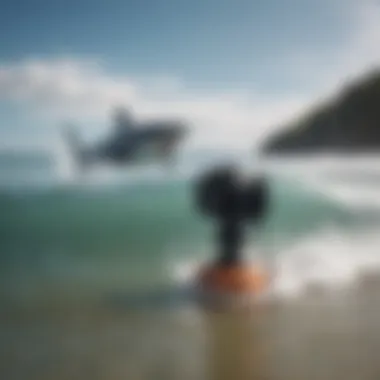
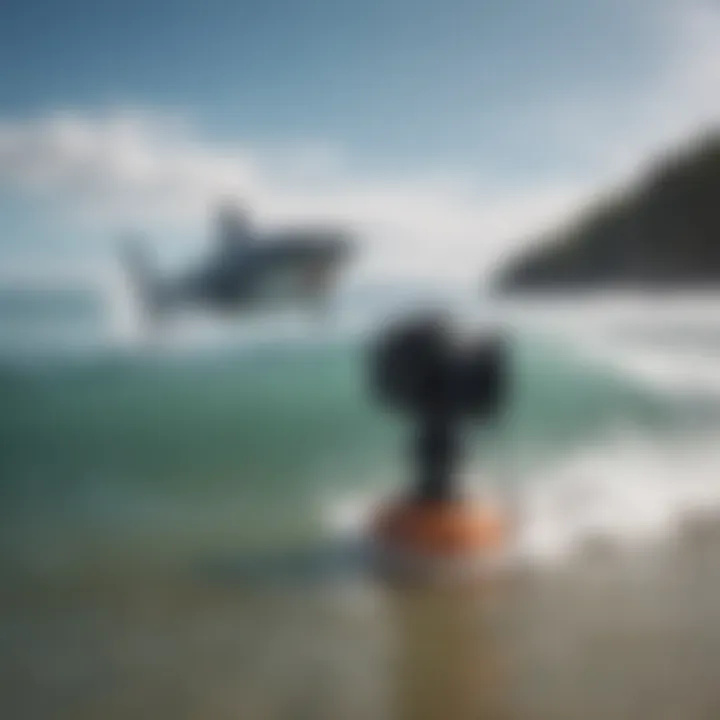
Intro
In the vast dance of waves and salty breeze, surfers often find themselves at the mercy of the ocean's whims. Surfing is not just a pastime; it's a communion with nature, a rush that dances on the edge of exhilaration and anxiety. As surfers paddle out, there lies a palpable concern that makes its home in the back of their minds: the shark. These majestic creatures, often portrayed as ferocious predators, could quite easily disrupt a day out on the water. Enter shark finders—tools that have evolved from basic technologies to sophisticated systems aimed at keeping surfers safe.
This narrative will unfold the evolution of these devices, how they function, and their significance not only for individual surfers but for the entire surfing community. As we explore the mechanics of shark finders, we’ll delve into their influence on shark behavior studies and environmental awareness. It is a story worth telling, as it showcases the intertwining of technology and nature.
Surfboarding Techniques
Navigating the waters involves more than just knowing your surfboard; it encompasses understanding how to approach the ocean with respect and skill. Whether you’re a newcomer or a seasoned pro, honing your techniques can enhance your experience and, more importantly, your safety.
Beginner Tips for Mastering the Basics
For those just getting their feet wet — quite literally — here are some handy tips:
- Understand the Ocean: Before hitting the waves, familiarize yourself with the beach. Note any currents and riptides, as these can be significant hazards.
- Paddle Position: When you’re out there, ensure you maintain a stable position on your board while paddling. Your body should be centered for better control.
- Start Small: Begin with smaller waves to build your confidence and skill. The ocean is unforgiving, and tackling bigger waves before you're ready can often end in a tumble.
Advanced Techniques for Seasoned Surfers
For the more experienced wave riders, mastering advanced techniques can elevate your surfing:
- Carving Turns: Engaging your body weight in turns is essential. Shift your weight toward your heels or toes for better control as you navigate waves.
- Wipeouts: Accept them as part of the game. Learning how to wipe out safely can prevent injuries. Tuck into a ball and cover your head when you know you're going down.
- Reading the Waves: The ability to read incoming waves can determine your success. Understand the swells and the timing needed to catch the perfect wave.
Surfboard Equipment
Equipping yourself with the right gear can make all the difference in how well you ride the waves. Here is an overview of what stays at the forefront of every surfer’s check list.
Reviews of the Latest Surfboards on the Market
Surfboards have seen a flurry of innovation over recent years. From construction materials to design features, today's boards cater to every style:
- Channel Islands High Performance: Known for their agile turns and acceleration, this brand remains popular among professionals.
- Firewire: Offering eco-friendly materials and lightweight designs, these boards provide speed and durability.
- Lost Surfboards: Renowned for their versatility, they handle various wave conditions while offering vibrant designs to stand out on the water.
Essential Gear for Every Surfboarder
Having the right gear can enhance not just performance but safety as well:
- Leash: A sturdy leash is non-negotiable. It keeps your board close even after a wipeout.
- Wetsuit: Choose a wetsuit that suits your climate. The right suit insulates against cold while allowing a natural range of motion.
- Wax: Surfboard wax increases grip on the board and prevents slipping, ensuring more control as you ride.
"Equipment is only half the battle; understanding your surroundings is equally crucial."
As we dive deeper into shark finders, we’ll unveil how they intertwine with these elements, enhancing safety and bringing awareness to the surf community.
Prelims to Shark Finders
Shark finders have emerged as vital tools in the intersection of human activity and marine ecosystems. The concern among surf enthusiasts has always been the presence of sharks in the waters they navigate, be it for recreation or professional pursuit. These tools not only enhance safety but also foster a greater respect for the ocean's inhabitants. Understanding this topic lays the groundwork for appreciating how technology can bridge the gap between adventure and awareness.
Defining Shark Finders
Shark finders refer to a range of sophisticated technologies designed to detect the presence of sharks in specific areas, primarily where surfers and swimmers gather. This could be anything from bands that use sonar to identify marine life patterns to mobile apps that provide real-time alerts based on sightings. These devices work by interpreting signals from various marine-based systems, helping to gauge shark movements, allowing individuals to make informed decisions about entering the water.
It's like having an extra pair of eyes beneath the waves, one that’s constantly scanning your immediate environment. As the technology behind these devices has developed, the tools have become more refined and user-friendly. Nowadays, surfers can rely on data-driven insights rather than just folklore or anecdotal evidence when it comes to shark encounters.
The Importance of Shark Awareness
Being aware of sharks is crucial for several reasons. First and foremost, knowledge breeds safety. Understanding shark habits and behaviors can drastically reduce the risk of unwanted encounters. Surfers equipped with shark finder technology are not just protecting themselves; they also contribute to the broader research and conservation efforts.
Sharks play an essential role in marine ecosystems, maintaining balance by controlling fish populations. However, misconceptions surrounding these creatures can lead to unnecessary fear and overreaction. By fostering awareness of sharks and their interactions with humans, we can work towards a more harmonious existence with these magnificent predators.
"Shark finders embody the intersection of technology and oceanic conservation, showcasing how informed use of tools can lead to safer interaction with our planetary waters."
Shark awareness extends beyond personal safety; it influences environmental advocacy as well. Surfers who understand the importance of these apex predators are more likely to support conservation laws and educate others, thereby playing their part in preserving the delicate marine balance. As surfers become ambassadors for the oceans, the integration of shark finders into their routines becomes not just common sense but also a step toward a more sustainable future.
Historical Context
Understanding the historical context behind shark finders is crucial when examining their evolution and current functionality. These tools didn't just appear overnight; they emerged from the interplay of ancient human experiences with sea life, particularly the need for safety in waters populated with sharks. Early encounters with these predators set the stage for how we perceive and interact with them today.
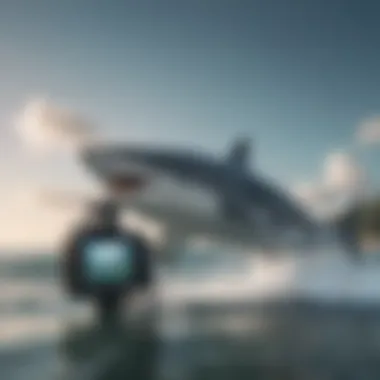
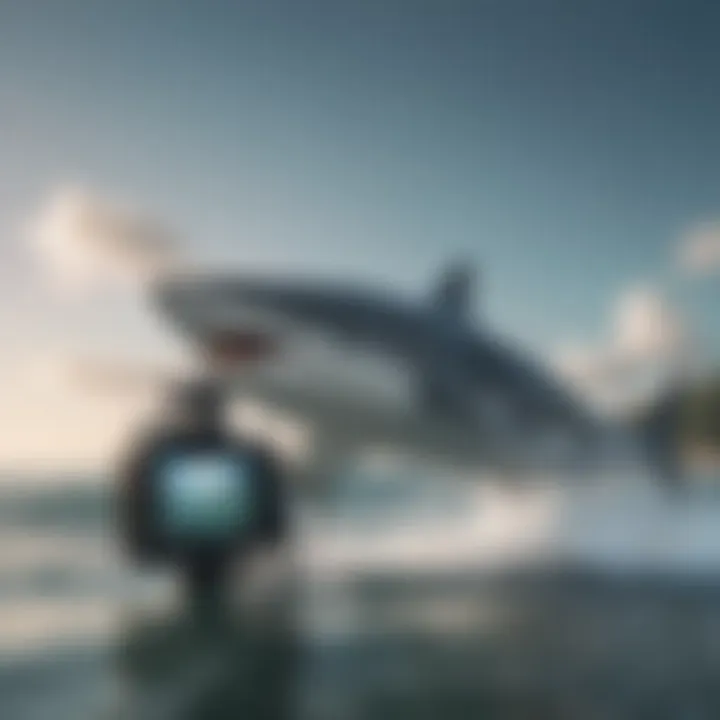
Early Shark Encounters
To make sense of today's technologies, one must reflect on those early shark encounters. Historical records show how various cultures regarded sharks. Some feared them, depicting them as vicious creatures in legends and folklore. Others respected sharks as key components of marine ecosystems. For example, indigenous peoples often utilized shark parts in various ways, from tools to dietary sources.
It's interesting to note that many maritime communities relied on anecdotal evidence when assessing the risk sharks posed. Fishermen would share tales of the largest sharks spotted, which influenced community guidelines regarding when and where to swim or fish. These exchanges created a collective understanding of shark behavior, which paved the way for observational studies much later.
Developing Technology
Having laid the groundwork of early shark encounters, we now transition into the era of developing technology that transformed how we monitor and understand sharks. Innovations in marine tracking have become pivotal in revolutionizing how surfers, researchers, and conservationists interact with shark populations.
Innovations in Marine Tracking
As the field of marine biology evolved, so did the tools researchers employed. The advancements in technologies specifically engineered for tracking marine life have had a profound impact on understanding shark habits and habitats. Notably, GPS and sonar technologies have rewritten the playbook for marine tracking.
A key characteristic of innovations in marine tracking is their precision. Take, for instance, the use of acoustic telemetry, which allows scientists to use sound waves to track the movements of tagged sharks over vast distances. This technique has proven to be immensely beneficial because it offers real-time data and facilitates a better understanding of migratory patterns.
A unique feature of this approach is its ability to operate in various environmental conditions, from bustling coastal waters to the open ocean. However, some challenges persist, such as data overload and the necessity for extensive monitoring equipment. Despite these hurdles, the rewards that come from this tech far outweigh the evils.
Rise of Electronic Detection
The rise of electronic detection has also been groundbreaking. More recently, devices like underwater drones and smart buoys have implemented exciting features designed for enhanced safety. What stands out about electronic detection is its capability for immediate feedback. For surfers, acquiring alerts about shark activity in the area could save lives.
The unique advantage of electronic detection lies in its interconnectedness. These devices often share data with both local authorities and the surfing community, leading to an enriched safety net. However, with technology, there also comes a cost—financially and in terms of potential environmental impacts. Overreliance on devices can sometimes conceal our innate link to the natural rhythms of ocean life.
"Understanding historical contexts and technological advancements acts as a bridge between the past and the present, creating safer pathways for surf enthusiasts today."
When we delve into shark finders' past, the technological evolution that has occurred is both fascinating and critical in making our oceans safer. Not only do these advancements highlight the resilience of human ingenuity, but they also encourage a more profound respect for the complex marine ecosystems sharks inhabit.
Understanding Shark Behavior
Understanding the behavior of sharks is paramount when it comes to improving surf safety and fostering a better relationship between humans and these magnificent creatures. It helps unveil the intricate social and feeding patterns that dictate their movement in coastal regions. Not just a matter of curiosity, this knowledge is vital for predictive measures and effective shark finder technologies. Having a grasp of shark behavior doesn't just keep surfers safer; it also cultivates respect for these animals and highlights their role in marine ecosystems.
Species of Interest
The ocean is a vast playground home to various shark species, but not all of them pose a significant threat to surfers. Here are some notable species that often capture the attention of surf enthusiasts:
- Great White (Carcharodon carcharias): This species is infamous for its size and power. Great whites are often found in colder waters and have been involved in most shark attacks on humans. Their hunting patterns can reveal much about where surfers might encounter them.
- Tiger Shark (Galeocerdo cuvier): Known for its distinctive stripes, the tiger shark's unpredictable behavior can be a challenge for shark finders. They tend to roam near shorelines and are highly opportunistic feeders.
- Bull Shark (Carcharhinus leucas): Adaptable and capable of surviving in both salt and fresh water, the bull shark is commonly found near river mouths and can sometimes stray into shallow waters.
By segmenting these species, surfers and conservationists can better understand which are more likely to inhabit certain areas at various times of the year, thus promoting safe surfing practices.
Patterns of Movement
Sharks aren't just aimlessly roaming the ocean; they have specific movement patterns influenced by a variety of factors. Recognizing these patterns is crucial for those who venture into surf waters. Here are a few essential elements:
- Seasonal Migrations: Many shark species migrate seasonally in search of warm waters or mating opportunities. Understanding these cycles helps predict when they might be in certain areas. For instance, great whites often make their way to certain locations during the warmer months, driven by prey availability.
- Feeding Zones: Sharks have preferred hunting grounds. Their movements are influenced by the movement of prey, typically schools of fish or seals, particularly in coastal areas where surfers tend to be active. Knowing these zones can help predict potential shark sightings and is a crucial element for shark finder technologies.
- Behavioral Responses: Sharks often react to environmental changes like water temperature, salinity, and even human activity, such as fishing or surfing. These behavioral nuances can be tracked and analyzed to enhance the efficiency of shark finders in providing alerts.
Understanding these movement patterns enriches the data that shark finders utilize, paving the way for not only improved safety but a deeper comprehension of marine life.
"The more we understand shark behavior, the better equipped we'll be to coexist with them in their domain."
In summary, examining shark behavior—ranging from species of interest to their patterns of movement—provides fundamental insights. These insights guide the development of shark finders, enhancing safety in surfing communities while fostering a respectful attitude towards these often-misunderstood creatures.
The Technology Behind Shark Finders
The technology employed in shark finders is a pivotal component within the landscape of ocean safety. As surfing enthusiasts increasingly share the waters with marine life, understanding how these devices operate can enhance safety while also nurturing conservation efforts. Shark finders utilize a blend of advanced systems to locate and track sharks in real time, making surfing pursuits safer and more informed.
Sonar and Acoustic Systems
Sonar, a term derived from the combination of sound navigation and ranging, primarily plays a crucial role in underwater shark detection. In its most basic form, sonar emits sound waves that travel through water, bouncing off objects and returning signals that provide data on their distance and size. This technology mirrors a simple echolocation that some marine creatures use naturally.
In shark finds, sonar systems are particularly effective. They can map out large areas of ocean and detect fin movements just below the surface. Keep in mind that this ability can be influenced by various factors such as water temperature and depth, which affect sound wave propagation.
- Benefits of sonar include:
- Continuous monitoring of specific ocean areas
- High precision in object detection
- Real-time feedback for immediate response
However, challenges exist too. The reliability of sonar can wane in turbid waters; heavy surf or debris can interfere with sound waves, leading to misinterpretations of data. Despite these hurdles, the innovation in this field continues to evolve, improving the clarity with which we can perceive our aquatic surroundings.
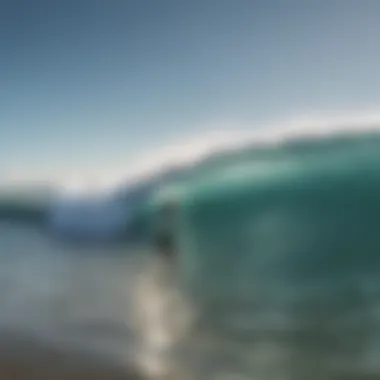

Radio Frequency Identification (RFID)
Radio Frequency Identification is emerging as another key player in shark detection systems. This technology relies on electromagnetic fields to automatically identify and track tags attached to devices or animals in the water. Shark tagging—an essential practice within marine biology—has turned into a powerful tool for understanding shark behaviors and movements.
For surfers, this means that tagged sharks can be monitored effectively, offering a type of alert system. When a tagged shark comes within a specified range of a surf area, notifications can be sent out.
- Highlighting key aspects of RFID technology:
- Real-time data sharing among researchers and local authorities
- Minimally invasive method for tracking sharks
- Potential for integrating shark movements into public safety alerts
Nonetheless, like any technology, RFID is not without its limitations. Environmental factors can affect the range and reliability of signals, and maintaining the integrity of tagging devices is essential to ensure continued data collection over time.
Satellite Monitoring
Then there's satellite monitoring, which elevates shark finders to a whole new level. This technology involves satellites scanning the ocean's surface and gathering vast amounts of data. By tracking water temperatures, currents, and surface conditions, researchers can infer patterns about where sharks are likely to be.
From a safety perspective, surfers benefit from this information, especially when conditions change rapidly. Also, this form of monitoring provides extensive data over wide geographical areas—far beyond what localized methods can achieve.
- Benefits include:
- Long-range surveillance of shark movements
- Ability to monitor ecological changes affecting shark behavior
- Enhanced collaboration with scientists and conservation organizations
Nevertheless, satellite monitoring does carry its own set of challenges. High costs related to satellite technology need to be addressed, and the data can sometimes be overwhelming or not specific enough for immediate use by surf communities. Yet, as technology advances, there is hope that these systems will become more accessible and user-friendly for everyone.
"The synergy of sonar, RFID, and satellite technologies not only improves safety for surfers but also fosters a deeper understanding of marine ecosystems."
In summary, the technology behind shark finders is a complex yet fascinating knitting of various systems working together. Each device's strengths can adapt to specific environments, forging a path toward safer and more responsible ocean encounters.
Applications in Surfing Communities
The presence of shark finders has become a significant aspect of surfing, enhancing safety and awareness in ocean waters where surfers frequently gather. In these communities, where the thrill of riding waves meets the unpredictability of marine life, the integration of technology helps mitigate risks while promoting responsible enjoyment of the sea. Shark finders serve not only as a tool for personal safety but also as a critical resource for educating surfers about the behavior and movement of sharks.
Enhanced Safety Measures
Shark finders have ushered in a new era of safety for surfers. By utilizing advanced technologies such as sonar and satellite monitoring, these devices provide real-time information about shark movements in the vicinity. This capability is vital, especially in areas known for frequent shark sightings. Moreover, many shark finders are designed to communicate with swimming bodies, sending alerts when sharks are detected nearby.
"Safety is not just a priority, it’s a reality we can create collectively with better tools and awareness tools."
Surfers can make informed decisions about ocean conditions before even paddling out. Here's a quick rundown of how enhanced safety measures translate into more secure surfing:
- Informed Decisions: Knowing the locations of sharks allows surfers to change their spots if necessary.
- Community Awareness: When everyone is informed, it leads to a shared sense of vigilance.
- Reduced Incidents: With timely warnings, shark-related accidents can be drastically minimized.
Integration with Surf Schools
Surf schools are integral to developing safe surfing practices and fostering the next generation of surfers. With shark finders, these institutions can amplify their safety protocols. By incorporating shark detection technology into their offerings, surf schools contribute to establishing a culture of safety and awareness.
- Training Programs: Instructors can educate students on how to recognize signs of shark activity and the importance of shark finders.
- Consistent Monitoring: Using shark finders during lessons ensures that schools can monitor shark movements, adding an extra layer of protection.
- Responsible Surfing Practices: Schools can incorporate discussions around conservation and the role of sharks in ocean ecosystems, creating well-rounded surfers.
Real-time Alerts for Surfers
Imagine a scenario where you're catching a wave, completely immersed in the experience, but a shark is lurking nearby. Thanks to real-time alerts provided by shark finders, surfers can receive instantaneous notifications, significantly increasing their chances of avoiding hazardous situations.
- Mobile Integration: Many shark finders now come with mobile app capabilities, allowing surfers to receive alerts directly to their phones.
- Community Alerts: Real-time systems can also inform nearby surfers, ensuring that everyone is on the same page regarding potential risks.
- Proactive Measures: The technology promotes a proactive approach, allowing surfers to enjoy the waves while being alert to their environment.
In summary, the integration of shark finders in surfing communities not only enhances safety but also enriches the surfing experience overall. By adopting the technology in surf schools and providing real-time alerts, these devices foster a culture of awareness and respect for the ocean, positively impacting both recreational activities and local ecosystems.
Environmental Considerations
Navigating the realm of shark finders isn't just about ensuring safety for the surfers; it also opens the door to deeper discussions about our relationship with marine life and the ecosystems we often overlook. The technology that aids in shark detection has significant environmental implications, creating a bridge between human activity and wildlife conservation. This section sheds light on how these tools contribute to shark conservation efforts and their influence on local ecosystems.
Shark Conservation Efforts
Shark populations face a myriad of threats, from overfishing to habitat loss. Recognizing this, conservationists have turned to technologies, including shark finders, as instruments for protection. These devices help track shark movements, allowing scientists to gather critical data about these creatures’ behavior and habitats. By understanding their patterns, conservation teams can advocate for protective measures effectively.
**"Sharks play a vital role in maintaining the health of marine ecosystems, yet they're often misunderstood and maligned."


Through organized research initiatives, data collected from shark finders can inform policies that aim to protect vulnerable species. This serves as a catalyst for creating marine protected areas, where sharks are safe from fishing and other disruptive activities. Moreover, engaging local communities in conservation efforts using real-time shark data fosters a sense of responsibility and stewardship.
Impact on Local Ecosystems
The presence or absence of sharks can indicate the health of ocean ecosystems. When shark populations decrease, it leads to trophic cascades—an imbalance that disrupts food webs and affects many species. Shark finders, therefore, not only assist in keeping surfers safe but also provide invaluable insights into the ecological structure of marine environments.
Monitoring shark populations can help identify which areas are thriving and which are under stress. Such insights can lead to focused conservation efforts in regions facing ecological challenges. By correlating shark movements with local environmental conditions, scientists can better grasp how climate change, pollution, and human activities affect these vital predators and their habitats.
This understanding allows for proactive measures. For example, by recognizing patterns in shark behavior and their interaction with prey species, conservation efforts can be tailored to ensure ecological balance. As surfers and eco-enthusiasts venture into the water, they must acknowledge that every wave they ride aligns with ongoing efforts to restore and maintain marine health. The interaction between shark finders and the broader conservation agenda illustrates the need for responsible practices in oceanic spaces, where every wave can signify a step towards a healthier ocean.
Challenges and Limitations
Shark finders hold immense potential for enhancing safety and fostering awareness in the dynamic realm of ocean activities. However, just like any technology, they come with their fair share of challenges and limitations that deserve attention. A balanced understanding of these hindrances is crucial, especially for surfers, instructors, and enthusiasts who rely on these systems in their ocean exploits.
Technological Hurdles
The technological landscape surrounding shark finders is not without its obstacles. Developing an efficient and reliable device capable of tracking elusive underwater creatures isn't easy. First off, many systems struggle with range and sensitivity. Some models might miss detecting sharks that are a few meters away, or they could easily malfunction under certain conditions, like poor weather or heavy sea movement.
Additionally, battery life presents a significant challenge for electronic monitoring devices. Imagine being out in the waves, your equipment running low, and then, just when you think you’re safe, the device shuts down. This means surfers might be left without real-time data, leaving them vulnerable and uncertain. It’s akin to setting sail without knowing the currents; even seasoned surfers would feel the weight of such a gamble.
Moreover, the integration of different technologies can be cumbersome. Many shark finders rely on sonar, RFID, or satellite monitoring to gather data, but these systems can sometimes fail to communicate effectively with one another. A device programmed for one type of detection may not easily adapt to another, forcing technicians to constantly tweak and improve the software, which often leads to unforeseen delays and expenses.
Data Interpretation Issues
Even when shark finders successfully gather data, interpreting that information comes with its own set of complications. For instance, the sheer volume of information generated by these devices can be overwhelming. Surf instructors and enthusiasts often face challenges sifting through this data, parsing out what is relevant to their needs amid a flood of extraneous details. Without clear guidelines on what to prioritize, there's a risk of misjudging shark behavior.
Misinterpretations do happen, where signals might indicate the presence of a shark when there is none, or vice versa. These erroneous readings can lead to unnecessary panic among surfers or, alternatively, a misplaced sense of security. It can be a precarious balance, akin to following a map that has landmarks obscured by foliage. The ambiguity and uncertainty meant that relying solely on technology can sometimes provide a false sense of safety.
A lack of training and knowledge in how to leverage these technologies effectively only compounds the issue. Many users are not familiar with interpreting sonar images or understanding the nuances of satellite data. Therefore, for shark finders to serve their intended purposes, there must be a concerted effort to provide education and tutorials that would help navigate these complexities.
Technology should enhance, not complicate, our pursuit of safety and understanding in the water.
In sum, while shark finders offer revolutionary insights into oceanic safety, their limitations present ongoing challenges that users must navigate carefully.
Future Directions in Shark Detection
The landscape of shark detection is changing faster than a surfer riding a wave. As technology advances, new options emerge that have the potential not only to enhance safety for recreational water users but also to provide valuable insights into marine biology. The next chapter in shark finder development may very well hinge on improved efficacy, accuracy, and more widespread adoption of these tools. The importance of this topic lies in the convergence of safety, scientific inquiry, and environmental stewardship.
Innovative Approaches
Innovative approaches to shark detection are akin to a fresh set of fins for a surfer – they provide an edge. One of the most promising directions is the integration of artificial intelligence with traditional monitoring systems. AI can analyze data patterns collected from various technologies like sonar and satellite tracking. This real-time analysis helps to predict shark movements with greater precision, which may ultimately lead to safer beaches.
Moreover, user-friendly apps linked with shark finding technologies present an exciting frontier. By allowing surfers to access alerts about shark sightings or movements, these tools bridge the gap between technology and community. Imagine a system where your mobile buzzes, alerting you not just of dangers, but of the beautiful creatures swimming beneath. Such innovations foster a culture of awareness and proactive decision-making.
"Shark finders are on the front lines of marine safety, merging technological advancements with community awareness for a safer ocean experience."
Collaboration with Conservationists
Collaboration with conservationists is vital in this evolving sphere. By working together, tech developers and marine biologists can ensure that shark detection systems contribute valuable data to ongoing conservation efforts. With the help of conservationists, shark finders can be tailored to gather data on migratory patterns, breeding grounds, and environmental factors affecting shark populations. This creates a win-win situation; beachgoers get improved safety, and scientists gain crucial information to inform conservation strategies.
Additionally, partnerships with conservation organizations can help raise awareness of ethical surfing practices. Integrating these messages into shark detection platforms not only promotes safety but also fosters a community ethos around respecting marine life. Putting a voice to conservation within these technologies will likely enhance users' sense of responsibility while enjoying the waters.
Both innovative technologies and collaborative endeavors will shape the future of shark detection. As these connections deepen, it's clear that surf culture can harmoniously coexist with marine conservation efforts.
End
As we navigate the complex waters of shark finders, it’s vital to grasp their significance, not just for leisure surfers but for the broader ecosystem in which they operate. The discussion presented in this article illuminates the dual purpose of shark finders: enhancing safety for ocean-goers while fostering an understanding of the delicate balance within marine environments.
Summary of Insights
Shark finders have evolved considerably over time. Each advancement stands on the shoulders of earlier innovations, transforming from rudimentary tracking systems to sophisticated electronic devices capable of real-time monitoring. These devices don’t only serve surfers; they also contribute to crucial scientific research. By tracking shark movements, we glean insights into their behavior, habits, and interactions with various oceanic ecosystems. This knowledge isn’t just for academia; it serves as foundational data for better conservation policies aimed at protecting these often-misunderstood creatures.
Shark finders exemplify technology’s role in promoting safety and environmental stewardship. They act as a bridge between adventure and responsibility on the waves.
In highlighting the marriage between technology and surf safety, it’s clear that awareness is keyword. The ability to anticipate shark presence significantly changes the game. This application of technology vastly improves surfing experiences while fostering respect for the ocean's natural inhabitants. The ongoing development of shark finder technology ensures a commitment to both safety and environmental conservation.
Call for Responsibility in Surfing Practices
With great surfing fun comes great responsibility. It’s imperative that the surfing community acknowledges their role in maintaining a safe and eco-friendly environment. Swimmers and surfers should familiarize themselves with the technology available to them. However, it goes beyond merely using these devices.
- Educate fellow surfers about the implications of shark finders and their usage.
- Adopt ethical practices in relation to marine wildlife. Respect their habitats, and engage in conservation efforts.
- Encourage local surf schools to integrate shark awareness into their training programs. By making it a standard part of safety education, the surfing culture evolves to prioritize ecological responsibility.
In closing, as we ride the waves, we must remain vigilant and respectful. The ocean is a living entity, teeming with life and complexity. Shark finders are not just tools; they're a means to ensure our shared space is safe for both humans and marine life, inviting surfers to harmonize their adventures with a conscientious approach to the environment.















